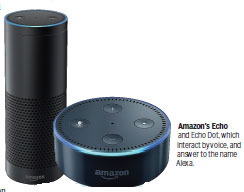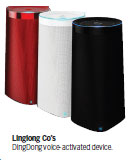Voice becomes smart-home star

In 2016, Amazon started a $100 million fund to invest in companies that will push the boundaries of voice-based interaction in smart-home and wearable products, and the company said it will expand into areas like robotics and healthcare.
Steve Rabuchin, head of Amazon's Alexa, said that that integration with mobile is a "particularly exciting opportunity because of the unique voice experiences that we think we can bring to our customers. We think they're going to love it."
"Smart products have always been in the realm of techies, because when there are not enough platforms, you have to basically build up the pieces yourself," said Alex Ruan, general manager of Sengled USA, a smart LED light bulb maker. "And that's not the typical consumer. Now with Amazon, with Google - especially with voice control - most people can use the smart-home technologies that are out there."
Sengled smart light bulbs are voice-activated and can do specific functions depending on the frequency of the noise it picks up from its surroundings.
"We're very keen on the simplicity of installation and the simplicity of setup and use. Amazons of the world solved a large part of [that] because I can now use voice activation and voice control, and it does solve the installation [aspect] of the product and the setup of the product as well," he said.
Richard Yu, CEO of Huawei's Consumer Business Group, declared the next five years the "intelligent revolution" where "everything is connected and all things are intelligent. The future devices will bring more [artificial intelligence]-infused services."
Blake Kozak, an analyst of smart-home technology at IHS Markit, said that "voice is definitely going to help bring smart home into the mainstream mainly because it will help with having to set up the smart home."
Though customers might have to use mobile applications right now, more and more products have direct integration with voice-control features, such as smart TVs and other home appliances.
A survey released prior to the 2017 Consumer Electronics Show by Coldwell Banker Real Estate LLC said that 72 percent of Americans who own smart-home products controlled by smartphones and tablets want voice control capabilities, and 48 percent currently own voice-controlled products.
Though the Chinese smart-home market is not as mature as the US', Chinese customers are quickly playing catch-up, as are the country's brands.
Late in 2016, Beijing-based LingLong Co introduced its version of the voice-activated virtual assistant, the DingDong. It looks similar to the Amazon Echo, but its selling point is that it can speak Chinese, which the Echo cannot. The machine costs $110 (698 yuan) and could be a good introductory product for those who are getting into smart-home goods, analysts said.

The Dingdong answers questions, manages schedules, provides directions, news, weather, and stock updates. and plays music and audiobooks. It is the first product from Linglong, a $25 million joint venture between JD.com, China's largest online retailer, and the Chinese information technology company iFlytek.
"We think that voice is the most natural way to connect," said Charlie Liu, LingLong's senior marketing manager, in an interview with tech magazine Wired. "You just need to say what you want. We think it is a really huge market."
In a recent GfK global survey, consumers said they expect smart-home services to have a big impact on their lives - bigger than wearables, connected cars, the Internet of Things (IoT), and six other emerging technologies. But what obstacles and expectations will Smart Home need to confront on its way to mainstream adoption?
In a March 2016 report based on data and interviews from 1,000 respondents in seven countries, German market researcher GfK said 75 percent of people interviewed in China said smart-home technology will have an impact on their lives in the next few years, compared to the global average of just more than 50 per cent, which makes the Chinese market one of the "best informed markets on smart-home technology, giving retailers, and suppliers a strong start," GfK said.
According to figures from research firm IHS Markit, 45 million shipments of connected-home devices were sent to customers in North and South American markets in 2016, compared to the 18 million across Asia, of which China, Japan, Korea, and Australia made up the bulk of. Shipments are counted by the manufacturers of the devices, which can originate from the domestic markets they were shipped to, or imported from other countries, according to IHS.
















